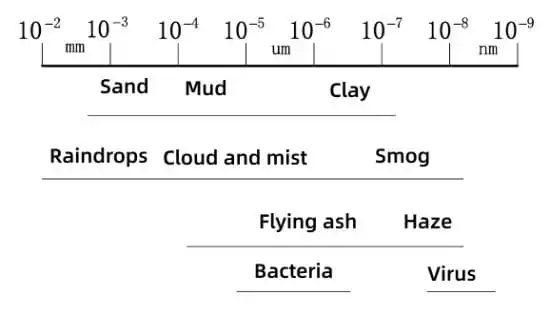An atmospheric particle refers to particles with extremely small particle sizes, which is one of the most important factors affecting the climate and the environment in which human beings live. Industrial production and human activities are the main reasons for the increase in the concentration of atmospheric particles caused by the pollution of the atmospheric environment. The use of coal in China's energy consumption exceeds 70%. As the main energy source in China, the air pollution caused by combustion and the pollution of chimney dust particles is extremely serious. The continuous growth of atmospheric particles seriously affects human health. Usually, particles larger than 10um can be discharged by the human body, while particles larger than 5um will be blocked by our mouth and nose and will not enter the body. Harmful substances such as bacteria, viruses, and heavy metals accompanied by particles smaller than 2.5um will participate in the human circulatory system. Particles smaller than 1um will participate in pulmonary circulation and adhere to lung cell tissue. If carcinogens such as sulfur dioxide, nitrogen dioxide, and benzopyrene are attached to the pores of the particles, it will seriously affect human health. On March 5, 2016, at the fourth meeting of the Twelfth National People's Congress, Premier Keqiang Li proposed to increase environmental governance, control air pollution, and deal with atmospheric smog, determining to adopt the win-win situation of economic development and environmental improvement. Therefore, it is of great significance to detect fine particulate matter PM2.5 and improve the application of dust concentration sensors in real life through a reliable, stable and economical solution in the fields of protecting human health and improving air quality.
The composition of atmospheric particles is very complex. It is a multiphase system composed of solids or liquids and gases suspended in the air. Substances invisible to the naked eye such as molecules, atoms, and ions are also included. The particle diameter span of natural particles is usually divided into seven magnitudes, as shown in Figure 1.1.

Figure 1.1 The distribution of particle size span of different particles
It can be seen from Figure 1.1 that the particle size span of the aerosol haze (liquid particles with cohesiveness and dispersion) which we are familiar with is 10-5 to 10-8m. Usually, primary aerosol particles produced in natural ecosystems such as natural fire combustion, sandstorms, volcanic eruptions, and biological particulate matter emissions, as well as secondary aerosols generated by conversion of natural emissions such as SO2, NO2, HS, and NH3 are natural aerosols. Primary aerosols produced by human activities such as coal combustion and industrial production and secondary aerosols transformed from gases produced by human activities are man-made aerosols. The sources of particles are diverse and the formation system is complex, and the health problems caused by carrying harmful substances into the human body are becoming more and more serious.
With the development of science and technology and the maturity of production technology, the technology related to the concentration of particulate matter has been widely developed and applied. The win-win development of economy and environment is also a long-term principle. Real-time measurement of environmental quality is very important for protecting the environment and improving people's environmental protection awareness and protection of human health are of great significance. At the same time, by analyzing the relationship between the particle size span of the particles formed by combustible combustion and the concentration of particles, the use of advanced dust concentration sensors also shows a broad development space in fire warning. Studying the particle concentration detection scheme and dust concentration sensor is of great significance in the fire early warning and indoor environmental quality detection for environmental protection, protection of people's life and property, human health, and guidance of human activities.
The composition of atmospheric particles is very complex. It is a multiphase system composed of solids or liquids and gases suspended in the air. Substances invisible to the naked eye such as molecules, atoms, and ions are also included. The particle diameter span of natural particles is usually divided into seven magnitudes, as shown in Figure 1.1.

Figure 1.1 The distribution of particle size span of different particles
It can be seen from Figure 1.1 that the particle size span of the aerosol haze (liquid particles with cohesiveness and dispersion) which we are familiar with is 10-5 to 10-8m. Usually, primary aerosol particles produced in natural ecosystems such as natural fire combustion, sandstorms, volcanic eruptions, and biological particulate matter emissions, as well as secondary aerosols generated by conversion of natural emissions such as SO2, NO2, HS, and NH3 are natural aerosols. Primary aerosols produced by human activities such as coal combustion and industrial production and secondary aerosols transformed from gases produced by human activities are man-made aerosols. The sources of particles are diverse and the formation system is complex, and the health problems caused by carrying harmful substances into the human body are becoming more and more serious.
With the development of science and technology and the maturity of production technology, the technology related to the concentration of particulate matter has been widely developed and applied. The win-win development of economy and environment is also a long-term principle. Real-time measurement of environmental quality is very important for protecting the environment and improving people's environmental protection awareness and protection of human health are of great significance. At the same time, by analyzing the relationship between the particle size span of the particles formed by combustible combustion and the concentration of particles, the use of advanced dust concentration sensors also shows a broad development space in fire warning. Studying the particle concentration detection scheme and dust concentration sensor is of great significance in the fire early warning and indoor environmental quality detection for environmental protection, protection of people's life and property, human health, and guidance of human activities.
Previous: Experimental Results and Analysis of PM2.5 Sensors
Next: The Testing Principle of NDIR




